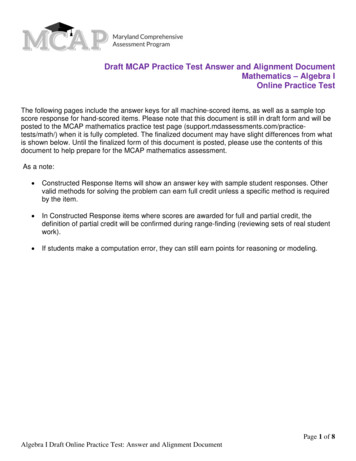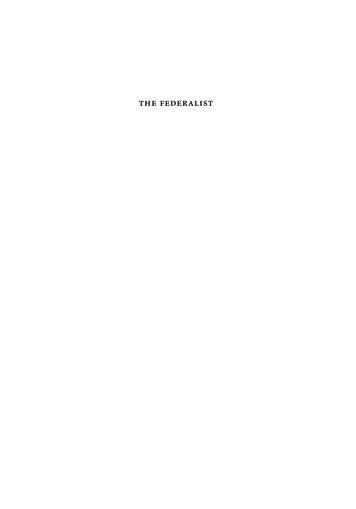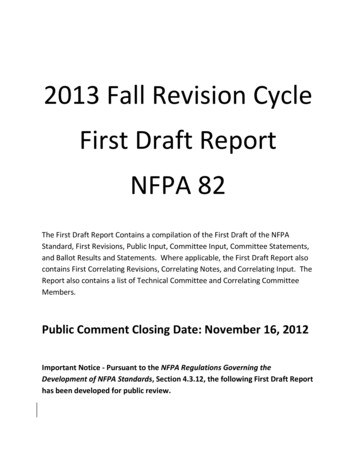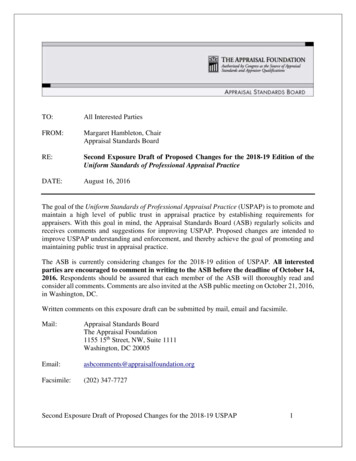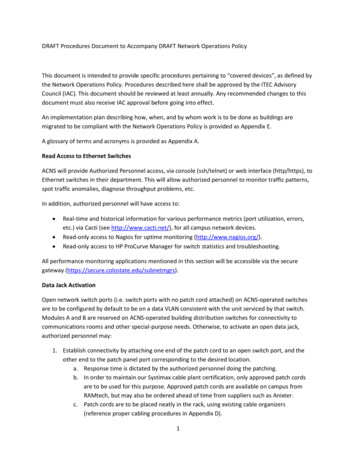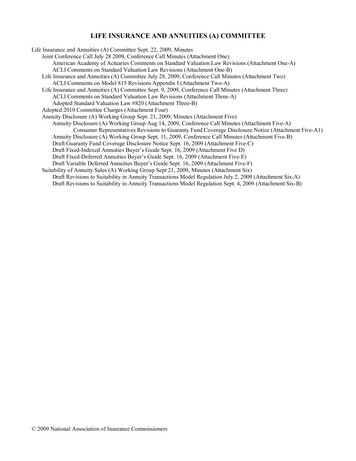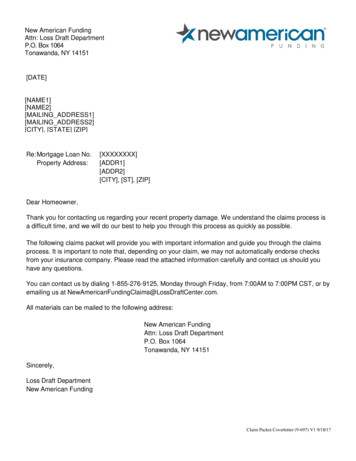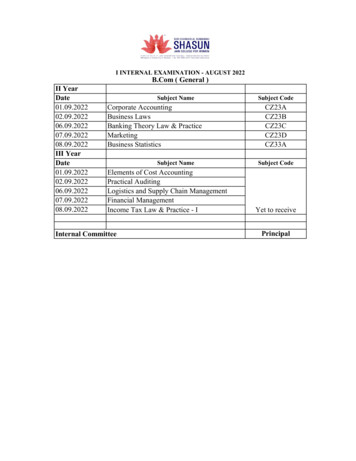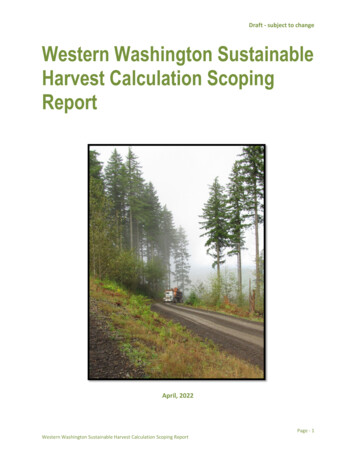
Transcription
Draft - subject to changeWestern Washington SustainableHarvest Calculation ScopingReportApril, 2022Western Washington Sustainable Harvest Calculation Scoping ReportPage - 1
Draft - subject to changeTable of ContentsAcronyms . 4Background . 5Public Scoping Process. 6Scoping Notice. 6Public Webinar . 7Website . 7Additional Opportunities to Comment . 8Comment Summaries . 8Topic: Alternative Development . 8Topic: Arrearage . 19Topic: Climate Change . 21Topic: Cultural Resources. 27Topic: Economic Analysis . 28Topic: Ecosystem Services. 34Topic: Elements of the Environment . 35Topic: Environmental Justice . 37Topic: Forest Estate Model . 38Topic: Forest Health. 41Topic: Inventory . 42Topic: Older Forest . 45Topic: Other Funding . 46Topic: Purpose, Need, and Objectives . 46Topic: Policy for Sustainable Forests . 51Topic: SEPA Process . 53Topic: Silviculture . 54Topic: Species Management . 55Topic: Sustainability . 56Topic: Timing with Pending Litigation . 56Topic: Trust Land Transfer . 58Topic: Trust Mandate. 59List of Commenters . 61Western Washington Sustainable Harvest Calculation Scoping ReportPage - 2
Draft - subject to changeAppendices. 62Appendix 1: Western Washington Forested State Trust Lands . 62Appendix 2: Western Washington Sustainable Harvest Calculation Scoping Notice . 64Appendix 3: Additional Information . 71Western Washington Sustainable Harvest Calculation Scoping ReportPage - 3
Draft - subject to changeAcronymsAFRCAmerican Forest Resource CouncilCLTCross-laminated timberCNWConservation NorthwestCO2Carbon dioxideDEISDraft environmental impact statementDNRWashington State Department of Natural ResourcesEISEnvironmental impact statementFEISFinal environmental impact statementFYFiscal YearGISGeographic information systemHCP1997 State Trust Lands Habitat Conservation PlanLiDARLight Detection and RangingLTCSLong-term Conservation StrategyNPVNet present valueOESFOlympic Experimental State ForestRCWRevised Code of WashingtonRDEISRevised Draft Environmental Impact StatementSBSenate BillSEPAState environmental policy actTACSustainable harvest calculation technical advisory committeeTLPATrust Land Performance AssessmentTLTTrust land transferU.S.United StatesWACWashington Administrative Code2SHBSecond Substitute House BillWestern Washington Sustainable Harvest Calculation Scoping ReportPage - 4
Draft - subject to changeBackgroundIn Washington State, the Department of Natural Resources (DNR) manages approximately 2.9 millionacres of state trust lands, not including aquatic lands. State trust lands are lands held in trust for specifictrust beneficiaries, such as public schools and universities. The term “state trust lands” refers to both StateLands and State Forest Lands: State Lands (RCW 79.02.010(14)) are lands granted to the state by the federal government atstatehood. State Lands are also referred to as federal grant lands. State Forest Lands (RCW 79.02.010(13)) are lands acquired by Washington State from thecounties. There are two types: State Forest Purchase Lands, which are lands purchased oracquired by the state as a gift, and State Forest Transfer Lands, which are lands transferred to thestate from the counties.As a trust lands manager, DNR’s responsibility is to manage these lands consistent with fiduciaryprinciples, which include producing a perpetual supply of revenue for specific trust beneficiaries. Onforested state trust lands, revenue is produced primarily through the harvesting of trees.Providing a perpetual supply of revenue requires responsible management with an emphasis on long-termsustainability. A major component of DNR’s approach to sustainable management is calculation of asustainable harvest level, which is the volume of timber to be scheduled for sale during a planning decadeaccording to applicable laws, policies, and procedures (RCW 79.10.300(5)). Put another way, thesustainable harvest level is the amount of timber DNR can harvest from forested state trust lands on acontinuing basis without major prolonged curtailment or cessation of harvest (RCW 79.10.310).The western Washington sustainable harvest level applies to all forested state trust lands located west ofthe Cascade Crest in Washington (approximately 1.4 million acres). These lands are divided into 20sustainable harvest units, each of which is assigned its own sustainable harvest level for the decade. Referto Appendix 1 for a map showing forested state trust lands in western Washington and a map showing thesustainable harvest units in western Washington. The west-side sustainable harvest unit consists of all State Lands (federal grant lands) and StateForest Purchase Lands located west of the Cascade Crest, with the exception of lands locatedinside the Olympic Experimental State Forest (OESF) and Capitol State Forest. OESF and Capitol State Forest consist of all State Lands (federal grant lands), State ForestPurchase Lands, and State Forest Transfer Lands located within their respective boundaries. Each of the 17 counties is a separate sustainable harvest unit for State Forest Transfer Lands.Each unit consists of all State Forest Transfer Lands located within their respective countyboundaries, with the exception of lands located in OESF and Capitol State Forest.The sustainable harvest level is measured in board feet, which is a unit of volume equivalent to a 12-inchsquare, 1-inch thick piece of wood. The level is recalculated every 10 years. To ensure one generation ofbeneficiaries is not favored over another, the next decade’s level cannot rise or fall more than 25 percentWestern Washington Sustainable Harvest Calculation Scoping ReportPage - 5
Draft - subject to changefrom the previous decade’s level (refer to the policy on the Definition of Sustainability for the SustainableHarvest Calculation in the Policy for Sustainable Forests (DNR 2006)).DNR is required to set a sustainable harvest level by Washington state law. Specifically, DNR mustperiodically adjust acreages designated for inclusion in the sustained yield management program andcalculate a sustainable harvest level (RCW 79.10.320). Sustained yield means harvesting on a continualbasis without major prolonged curtailment or cessation of harvest (RCW 79.10.310). The sustainableharvest level is a policy decision that requires approval from the Board of Natural Resources.DNR calculates the sustainable harvest level through a forest estate modeling process. The forest estatemodel is a mathematical, computer-based representation of the forest. Capable of manipulating vastquantities of data, the model is able to look across landscapes and decades to determine the sustainableharvest level that is the best balance of DNR’s management objectives, which include both revenueproduction and ecological values such as wildlife habitat.Public Scoping ProcessScoping is the first formal step in preparing an EIS and initiates public involvement. Analysis ofcomments received during public scoping helps DNR to: narrow the focus of the EIS to significantenvironmental issues, eliminate issues that would have insignificant impacts or that are not directlyrelated to the proposal, identify alternatives to be analyzed in the EIS, and identify mitigation measuresthat address potential environmental impacts of the proposal.Scoping NoticeOn October 25, 2021, DNR issued a Determination of Significance and Public Scoping Notice for theproposal to establish a sustainable harvest level for the 2025 to 2034 fiscal year planning decade forforested state trust land in western Washington, indicating that an Environmental Impact Statement (EIS)would be prepared (Appendix 2). (RCW 43.21C.030(2)(c)). In the scoping notice, DNR invited agencies,affected tribes, and members of the public to comment on the scope of the EIS, specifically asking forcomments on alternatives, mitigation measures, probable significant adverse impacts, and licenses orother approvals that may be required, adding that if the commenter was suggesting a particular approachor impacts to consider, to please explain why. The scoping notice went on to explain that the moreWestern Washington Sustainable Harvest Calculation Scoping ReportPage - 6
Draft - subject to changeevidence provided in support of a comment, such as peer-reviewed studies or reports, the more useful thatcomment would be to DNR in its analysis. Suggested comment topic areas included the following: Probable significant environmental impacts that need to be considered in the adoption of thesustainable harvest level. Key environmental issues that need to be addressed and analyzed by one or more of thealternatives. Alternatives that need to be considered that will meet the need for, and the purpose of, theproposal. Specific mitigation measures that DNR should consider to avoid or minimize impacts. Identification of additional environmental information, studies, or reports relevant to thedevelopment of sustainable harvest level alternatives.In addition, the scoping notice opened a 45-day public comment period starting on October 25, 2021 andending on December 9, 2021; announced a date for a public webinar, which is a public meeting held overthe internet; and provided a link to a survey for meeting participants to use in order to submit commentsto DNR as well as an option to email comments to DNR staff. This notice was sent through the U.S.Postal Service and by email to a list of agencies, individuals, and organizations interested in state trustlands management decisions. In addition the notice was posted on DNR’s website at “SustainableHarvest Calculation” as well as on DNR’s SEPA Center website. DNR also issued a press releaseannouncing a public webinar.Public WebinarDNR held a live public webinar at 6:00 p.m. on November 9, 2021. A recording of the webinar was madeavailable for public viewing on DNR’s website starting November 16, 2021. The scoping notice provideda link for anyone interested in attending the webinar to use in order to register for the webinar. Thewebinar discussed six topics: background information on Washington state trust lands; information onDNR’s separate, but concurrent sustainable harvest calculations; the environmental review steps that arepart of an EIS; the purpose of scoping; information on the western Washington sustainable harvestcalculation project proposal; and how to make effective comments to DNR during the scoping period.Participants asked several questions during the webinar and were encouraged to formally submitcomments using either Survey Monkey or email. Twenty-five non-DNR attendees viewed the webinar.These attendees included unaffiliated members of the public, representatives of environmentalorganizations, timber industry organizations, local government, library districts, and trust beneficiaries.WebsiteDNR provides information about the western WA sustainable harvest calculation on a website dedicatedto the topic at https://www.dnr.wa.gov/shc and at the DNR SEPA Center website atWestern Washington Sustainable Harvest Calculation Scoping ReportPage - 7
Draft - subject to alculation-west. Each of these websites provided links tothe scoping notice and other background documents, as well as details about the comment period and thepublic webinar.Additional Opportunities to CommentAlthough the public scoping comment period has now closed, additional opportunities for the public tocomment on the sustainable harvest calculation are available at every Board of Natural Resourcesmeeting, which occur on the first Tuesday of each month, except for August, and begin at 9:00 a.m.Agendas for these meetings are posted three business days before the meetings and include a standingtopic for the public to comment on any item of interest that they may have. More information about thesemeetings is available on the Board of Natural Resources web site (Board of Natural Resources WA DNR).Comment SummariesDNR received comments from 21 different individuals or groups. The comments were submitted throughSurveyMonkey (18 comments) or email (3 comment). Commenters affiliated with stakeholder groups,including environmental advocacy and industry groups as well as citizens’ councils, tribes, andbeneficiaries, accounted for 18 of the commenters, while 3 commenters were unaffiliated members of thepublic.Scoping comments were categorized into 22 different topics that were identified during the scopingprocess. Comments were further categorized into subtopics. In some cases comments from differentcommenters were combined into a single comment when the theme of the comments were similar. Acommenter identification number is provided for each comment and the associated commenter may befound in Table 1 below.Topic: Alternative DevelopmentSubtopic: Technical Advisory CommitteeSUMMARY OF COMMENTRecommends including the Technical Advisory Committee recommendations and any impacts that mayresult from doing so in the SEPA analysis.Commenter9Western Washington Sustainable Harvest Calculation Scoping ReportPage - 8
Draft - subject to changeSubtopic: Trust MandateSUMMARY OF COMMENTWhen developing alternatives consider maximizing financial returns to beneficiaries on a sustainablebasis. In addition, consider the direct financial impact on beneficiaries and the broader economic impactson counties from decisions that pursue strategies other than timber harvest. The study by Mason Bruce &Girard and Highland Economics is a valid model to calculate those impacts.Commenter9SUMMARY OF COMMENTAll alternatives should reflect existing trust requirements and state law. Theoretical changes to either ofthose are the purview of the legislature and courts and should be left to them.Commenter14Subtopic: Carbon and Climate ChangeSUMMARY OF COMMENTIf any of the alternatives include evaluating carbon market potential, please also consider how harvestrotation lengths impact additionality and the potential for utilizing carbon markets to generate revenueCommenter9SUMMARY OF COMMENTWhen developing alternatives and considering changes to forest management and harvest of forestproducts due to climate change impacts and any related impacts to future growth rates, please alsoconsider the following: Whether it is advantageous to capture the value of certain forest products in the short term tomitigate risks of fire loss; How sequestration rates may be impacted; and How best to adapt forest management strategies to capture the value of forestland assets in aWestern Washington Sustainable Harvest Calculation Scoping ReportPage - 9
Draft - subject to changesustainable way that maintains and enhances revenues and overall economic benefits.Commenter9SUMMARY OF COMMENTSThe calculation should incorporate climate resilience, forest health, carbon sequestration, andmodernization of DNR silviculture as core components in each alternative that is drafted and considered,to reflect the reality of the climate crisis and its interaction with forest ecosystems.Commenter15SUMMARY OF COMMENTSDNR must develop a “climate smart alternative”.Commenter6, 15, 19SUMMARY OF COMMENTSThe climate smart alternative must: Account for all environmental costs of harvest weighed against the benefits of DNR-managedforests as carbon sinks. Be part of all reasonable alternatives and focus on forest health in the strategies it employs,meaning it must increase forest resilience and carbon sequestration at a minimum and include: oUneven-aged managementoLonger rotations than business-as-usualoGreater retention during harvestoThinning, restoration, and innovative silviculture to advance structural complexity, agediversity, biodiversity, reduce drought stress, and other factors that increase resilience.Particularly since the vast majority of DNR lands are in the competitive exclusion phaseand lack these characteristics of resilience.oMaintaining and improving site productivity.Protect and restore the world’s most productive terrestrial carbon sink, halt further loss of at-riskplants, fish, and wildlife, and transition trust revenue streams towards carbon and otherWestern Washington Sustainable Harvest Calculation Scoping ReportPage - 10
Draft - subject to changeecosystems services and away from timber. Such a transition is critical for maximizing trustrevenues, reducing risk of loss from climate change, and protecting the wellbeing of futurebeneficiaries – three of DNR’s most important trust responsibilities. Achieve four goals:oreduction of logging related emissionsoincrease carbon stored on the landoincrease carbon sequestered by DNR forests on an annual basis; andoincrease the landscape's resiliency to climate change.include the followingoA specific program of actions to meet greenhouse gas specific targets for forests.oA network of forest carbon reserves on DNR lands. These native, legacy, old growth,mature and structurally complex stands must be permanently deferred from harvest.oA switch of all variable retention harvest of younger stands to variable density thinning toexpedite their development into carbon rich late successional/old growth forestsoTrust revenue diversification to prioritize income from payments for carbon storage andpayments for other ecosystem services.oA restoration program for priority watersheds using carbon revenues.oA reduction of habitat fragmentation and significant limits on new road construction.Establishing a network of forest carbon reserves on DNR-managed lands, including all native,legacy, old growth, mature, and structurally complex stand limiting timber harvest to variabledensity thinning of young tree plantations; and diversifying trust revenue stream to prioritizeWestern Washington Sustainable Harvest Calculation Scoping ReportPage - 11
Draft - subject to changeincome from recreation, tourism, conservation leasing, conservation land sales, payments forcarbon storage, and payments for other ecosystem services.Commenter6, 15, 19SUMMARY OF COMMENTCommenter provided the links for information on climate smart forestry and carbon sequestration,available in Appendix 3.Commenter15SUMMARY OF COMMENTThe DIES should include a climate smart alternative which causes no climate harm and aggressivelyhelps to reduce climate change. Incorporates by reference the public comments made during the livewebinar on December 9, 2021 regarding a climate smart alternative.Commenter13SUMMARY OF COMMENTDNR should consider at least one alternative that dramatically increases the amount of carbon stored onDNR-managed lands during out the planning period.Commenter17SUMMARY OF COMMENTThe agency needs to do more than just minimize impacts. It needs to be forward-thinking and prioritizeresilience; the analysis should assess which alternatives provide the greatest addition to resilience andinclude an analysis of the amount of carbon stored on the landscape and expected carbon flux for theWestern Washington Sustainable Harvest Calculation Scoping ReportPage - 12
Draft - subject to changelands of each trust beneficiary (common schools, counties, etc.) under each alternative. It should alsoanalyze the cumulative impact of harvest on carbon storage and emissions for each alternative.Commenter15SUMMARY OF COMMENTIt is well established scientific fact that carbon storage and carbon sequestration vary widely as a functionof stand age. The sustainable harvest calculation DEIS needs to develop and incorporate data on DNRforest stands by Age Class groupings that include: Stand age area data stratified by county and DNR Trust land category (Common Schools, StateForest Transfer, etc.) both in (1) tabular format and (2) a mapped format drawn to a scale that canbe readily interpreted. These age classes should at least include:ooooooo 0-50 years50-65 years65-80 years80-100 years100-120 years120 years and olderInclude both the area data tables and maps in the sustainable harvest calculation DEIS.In conformance with “Sustainable Harvest Calculation Proposal: Objective 2” that “Consider[s]climate change as part of the affected environment, analyze climate change impacts and benefitsof the alternatives, and identify possible mitigation measures that will reduce or eliminate anyidentified adverse environmental climate change impacts of the proposal.” In order for thissustainable harvest calculation update to conform with its stated objectives, the commenterrequests the follow analyses be performed and included in the sustainable harvest calculationDEIS:oAn analysis of the potential for carbon sequestration and carbon storage by stand ageclass for all DNR lands and include these analyses in the sustainable harvest calculationDEIS.oAn analysis defining the optimum age class ranges where carbon storage is maximizedand include these analyses in the sustainable harvest calculation DEIS.oRelate the stand age classes to the stand ages defined and mapped above as requested.Western Washington Sustainable Harvest Calculation Scoping ReportPage - 13
Draft - subject to changeCommenter20SUMMARY OF COMMENTThe commenter expects that, in the sustainable harvest calculation DEIS, DNR would include: Current values of carbon that are stored and annually sequestered in the forest ecosystems in thesustainable harvest calculation DEIS analysis area. These annually sequestered values mustaccount for all components of the ecosystem, not just the trees. The values for carbon storedassociated with the trees must account for carbon secured in each age class, including 0-50 years,50-65 years, 65-80 years, 80-100 years, 100-120 years, and over 120 years. These data shouldseparate Natural Area Preserves and Natural Resource Conservation Areas from other trust landswhere timber can be harvested. An estimate of the amounts of carbon that are currently stored, and annually sequestered, that willbe impacted in the sustainable harvest period. Provide this data for the several sequestrationsources listed in item #1 above. An analysis of the amount of carbon which will be emitted through all components of the“harvest to product” life cycle including the CO2 given off in road building, harvesting,transportation of logs, log processing, distribution of finish wood product materials to commercialoutlets and other factors associated with cutting and processing that the sustainable harvestcalculation DEIS process will initiate. A discussion of the difference in carbon stored and sequestered between the several thinning andclearcutting (variable retention harvest) harvest methods.Recent research (Hudiberg et al) 2019 has found that employing longer rotation ages can providemore benefits and less environmental damage when compared to shorter rotation ages, therefore thecommenter requests that DNR estimate the volume of timber harvest, carbon lost and impacts on eachof the several ecosystem services based on rotation ages of 40-, 50-, 60-, and 80-year cycles in thesustainable harvest calculation DEIS.Commenter20SUMMARY OF COMMENTDNR has claimed that the substitution of wood for other building products and/or embedded carbonstored in building products justifies forestry from a carbon perspective. Recent research from Moormanand Law show this may not be true when the whole life cycle of the forest ecosystem is evaluated alongwith energy lost in the ‘harvest to product” is considered. Therefore, the DNR needs to conduct anextensive search of all peer reviewed research and document these findings in the sustainable harvestcalculation DEIS. Furthermore, DNR needs to refrain from stressing that product substitution andWestern Washington Sustainable Harvest Calculation Scoping ReportPage - 14
Draft - subject to changeembedded carbon is beneficial to the carbon balance unless and until all the relevant research has beenevaluated and found to support the contention noted above.Commenter20SUMMARY OF COMMENTCommenter attached comments submitted on the Taylor Downhill Sorts timber sale. Commenter alsoattached a write-up and list of key literature on drought and heat wave impacts to forests.Commenter19Subtopic: Natural DisturbanceSUMMARY OF COMMENTDNR should consider various levels of natural disturbance in alternatives.Commenter7Subtopic: Older ForestsSUMMARY OF COMMENTSDNR claims to be taking a landscape approach to management but in reality focuses conservation in theOlympic Peninsula, coastal uplands, and high Cascades, and relies primarily on stream buffers to meetolder forest requirements in southwest Washington and many lowland watersheds in Puget Sound, whileignoring criteria for patch size and edge effects described in the final environmental impact statement forthe 2006 Policy for Sustainable Forests. DNR claims to be able to log potential marbled murrelet habitatnot specifically protected by the marbled murrelet long-term conservation strategy, again ignoring theWestern Washington Sustainable Harvest Calculation Scoping ReportPage - 15
Draft - subject to changemulti-species conservation strategy in the 1997 HCP. The 2025 to 2034 sustainable harvest calculationmust include alternatives that assumes the HCP protects these older forests.Commenter7SUMMARY OF COMMENTDNR should exclude all older growth forests from the 2025 to 2034 sustainable harvest calculation. Atthe least, DNR should comply with the 1997 HCP requirement of maintaining 10-15 percent of each HCPplanning unit in forests 70-100 ears of age by adopting an alternative that protects all structurally complexforest greater than 100 years of age.Commenter7SUMMARY OF COMMENTAll alternatives should comply with an anticipated older forest policy.Commenter17SUMMARY OF COMMENTTo prevent further loss and degradation of native species populations and habitat, DNR needs to protectlegacy forests that are naturally regenerated by permanently withdrawing them from timber harvest. Thiswould benefit at-risk species, including the northern spotted owl and marbled murrelet. This is especiallyimportant when considering the cumulative impacts of private forest
As a trust lands manager, DNR's responsibility is to manage these lands consistent with fiduciary principles, which include producing a perpetual supply of revenue for specific trust beneficiaries. On forested state trust lands, revenue is produced primarily through the harvesting of trees.
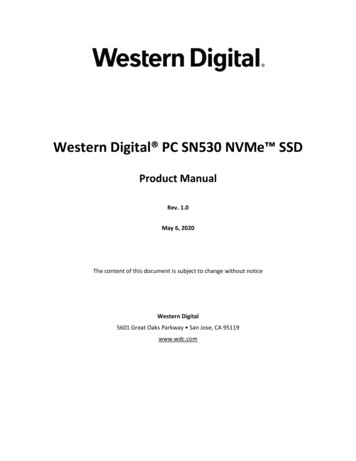
![Change Management Process For [Project Name] - West Virginia](/img/32/change-20management-20process-2003-2022-202012.jpg)
